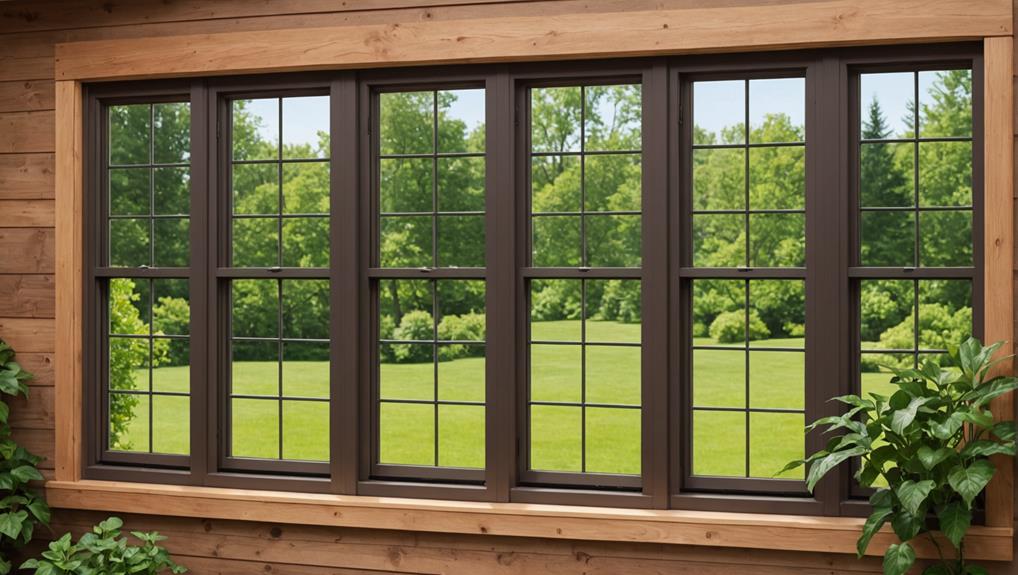When you're looking for top window replacement materials that boost energy efficiency, consider the frame, glazing, and insulation. Vinyl frames offer great insulation, while fiberglass provides outstanding thermal performance. For glazing, insulated units with Low-E glass minimize heat loss by up to 50%. Incorporate warm edge spacers and inert gas fills to further enhance performance. Choose operating styles like casement or fixed windows for tight seals and reduced air leakage. Remember, monitoring U-Factor and SHGC ratings is key. You'll discover many options to suit your needs and improve your home's efficiency as you explore further.
Key Takeaways
- Vinyl frames provide excellent energy efficiency and insulation, making them a top choice for window replacement.
- Fiberglass frames offer outstanding thermal performance with air cavities that enhance insulation.
- Wood frames, when properly maintained and clad, can deliver good insulation properties.
- Insulated glazing units (IGUs) with Low-E glass significantly reduce heat loss and improve energy performance.
Window Frame Materials

When choosing window frame materials, you'll find a variety of options, each with its own advantages and drawbacks.
Vinyl frames stand out as the most energy-efficient option, boasting superior insulating properties and resistance to warping or deterioration over time.
If you're considering wood frames, they offer good insulation but require regular maintenance. You can enhance their performance by adding cladding to reduce upkeep.
Fiberglass frames are another excellent choice, providing outstanding thermal performance and stability thanks to air cavities that improve insulation efficiency.
If you're looking for a balance, composite frames combine wood products with polymers, delivering moisture resistance and thermal stability while minimizing maintenance needs.
On the other hand, metal frames are the least energy-efficient due to their heat-conducting properties. However, you can improve their insulation performance by incorporating thermal breaks, which use insulating plastic strips to combat air leakage.
Glazing Options
Choosing the right glazing options can greatly enhance the energy efficiency of your window replacement project, building on the advantages of your selected frame materials. One effective choice is insulated glazing units (IGUs). These consist of multiple panes of glass filled with inert gases like argon or krypton, which markedly improve thermal performance and reduce heat transfer.
Low-E glass is another excellent option; its thin metallic oxide layer reflects infrared and UV light, leading to energy savings by reducing heat loss by 30% to 50%. Incorporating warm edge spacers in IGUs can further enhance performance by lowering the U-factor and minimizing condensation.
If you live in hotter climates, consider glazing with spectrally selective coatings. These coatings filter out non-visible infrared radiation, improving cooling efficiency.
Here's a quick overview of glazing options:
| Glazing Type | Benefits | Ideal Use |
|---|---|---|
| Insulated Glazing Units | Improved thermal performance | All climates |
| Low-E Glass | Reduces heat loss by 30%-50% | Energy-efficient windows |
| Inert Gas Fills | Minimizes heat transfer | Standard and narrow gaps |
| Spectrally Selective Coatings | Enhances cooling efficiency | Hot climates |
Insulation Technologies

Effective insulation technologies are essential for maximizing the energy efficiency of your window replacement, ensuring comfort in any climate.
One of the best options is insulated glazing units (IGUs), which consist of double or triple-pane glass filled with argon or krypton gas. These gases considerably reduce heat transfer, enhancing thermal efficiency.
Adding Low-E coatings to energy-efficient glass can further decrease energy loss by 30% to 50%, making your windows even more effective at keeping your home comfortable year-round. While these coatings might add a slight increase to your initial costs, the long-term energy savings often justify the expense.
For those in extreme climates, triple-pane options provide superior insulation properties, reducing the demand for heating and cooling.
Utilizing warm edge spacers in your IGUs also contributes to improved thermal efficiency by lowering the U-factor and minimizing condensation.
Operating Styles
Exploring various window operating styles helps you find the perfect balance between energy efficiency and ventilation for your home.
Fixed windows stand out as the most efficient option since they don't open, completely eliminating air leakage and maximizing thermal performance.
If you prefer windows that open, consider casement windows; their outward-hinged design creates a tight seal when closed, offering excellent insulation.
Awning windows are another great choice, hinged at the top, allowing for ventilation even during rain while minimizing air leakage.
On the other hand, sliding windows are convenient but often have higher air leakage rates, which can compromise energy efficiency.
Double-hung windows provide operable sashes for ventilation, but their performance relies heavily on how well they're sealed and maintained.
If you're looking for a window replacement, it's essential to weigh these operating styles carefully.
Insulated windows can enhance energy efficiency regardless of the style you choose, but opting for designs with tighter seals will greatly improve your home's comfort.
Ultimately, understanding these different operating styles will help you make an informed decision that meets your needs.
Energy Performance Ratings

Understanding energy performance ratings is essential for selecting windows that enhance your home's energy efficiency and comfort.
The U-Factor measures heat transfer rates; a lower U-Factor indicates better insulation, typically ranging from 0.2 to 1.2. You should also consider the Solar Heat Gain Coefficient (SHGC), which shows how much solar radiation enters your home. In hot climates, lower SHGC values help minimize cooling costs, while higher values can be beneficial in colder areas by allowing in solar heat.
Look for windows that meet ENERGY STAR certification, as they adhere to strict performance guidelines set by the EPA and DOE, ensuring significant savings on energy bills. The National Fenestration Rating Council (NFRC) provides independent testing and labeling of window performance, helping you make informed decisions.
Don't overlook insulated glazing units (IGUs) with Low-E glass, which can reduce heating and cooling costs by 30% to 50%. These advanced glazing technologies are crucial for achieving higher energy performance ratings, ultimately leading to a more comfortable home and lower energy expenses.


Leave a Reply